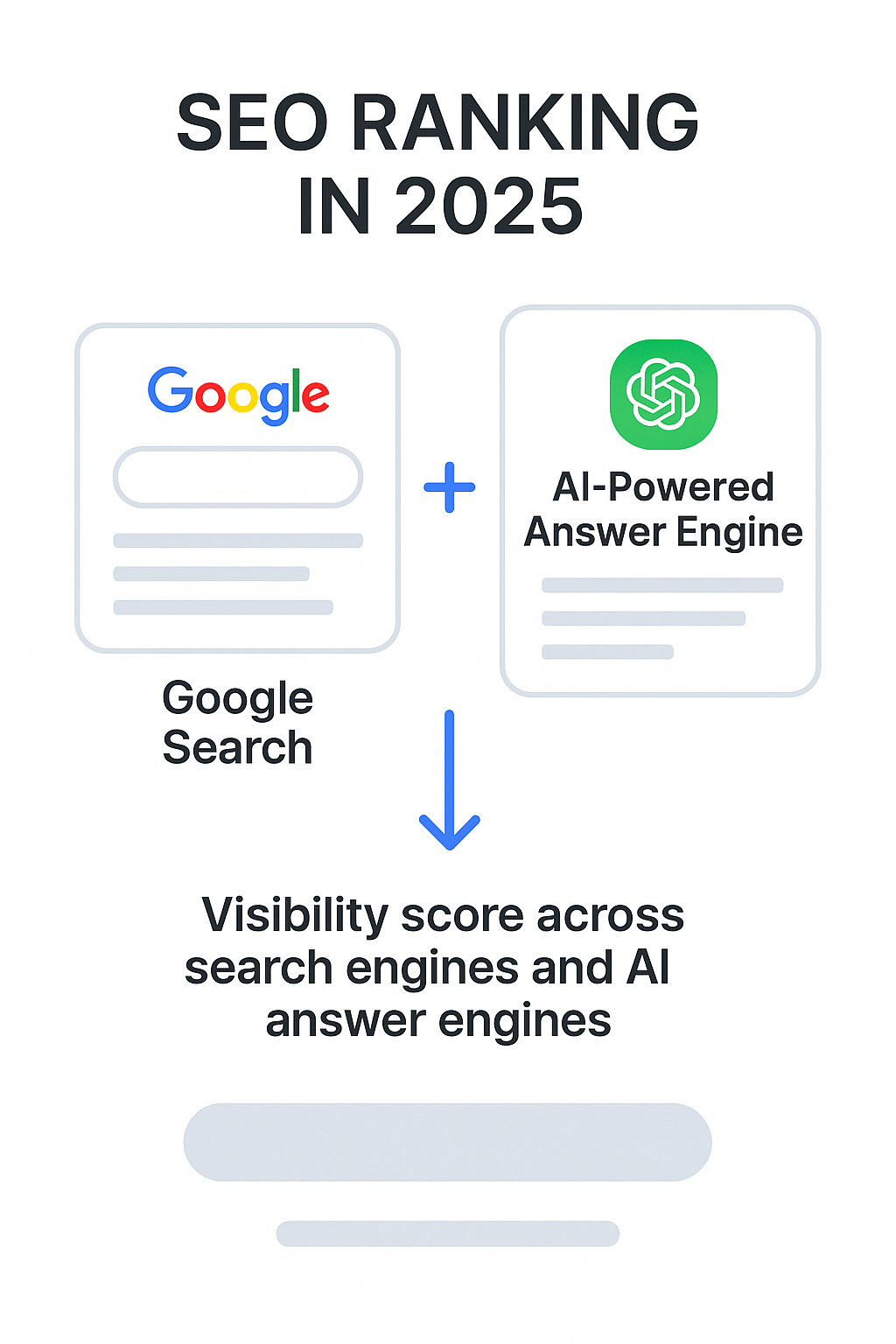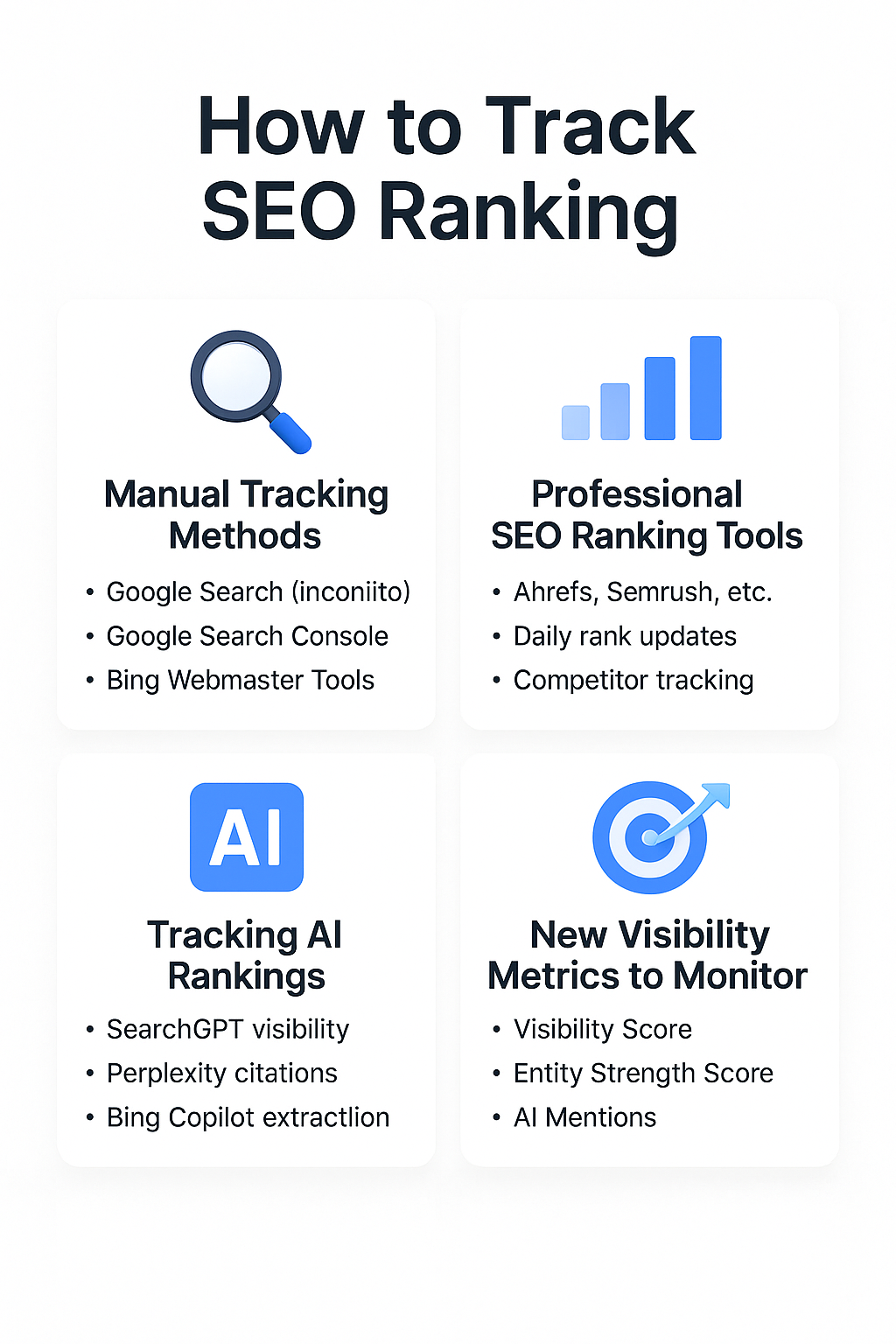November 21, 2025
Semantic Blocks: The New Structure of AI-Optimized Content
November 20, 2025
Multimodal SEO: How AI Uses Images, Video & Diagrams to Rank Pages
November 19, 2025
Author:
.png)
At its simplest, SEO ranking is the position of a page in search results for a specific keyword. This classic definition worked for years — when search engines only meant Google SERPs and blue links.
But in 2025, this definition is outdated.
Search is no longer just a list of results. Users now discover information through Google, but also through AI-powered answer engines like SearchGPT, Perplexity, and Bing Copilot. These systems don’t just show links — they summarize, rank sources, and cite content inside conversational answers.
This means your “ranking” is no longer a single position on page one.
It is a multi-surface visibility score across traditional search and AI-generated answers.
SEO ranking in 2025 is not just a position — it’s a visibility score across search engines and AI answer engines.
To understand SEO today, you need to understand how both Google and AI models choose what to show, what to cite, and what to recommend.
Modern SEO ranking is shaped by two parallel systems:
Google’s traditional ranking algorithms and AI-driven retrieval and citation systems.
Google still relies on classic ranking factors, but with deeper nuance:
Google ranking is still position-based, but heavily affected by context and intent.
AI engines such as SearchGPT and Perplexity work differently:
They don’t rank pages.
They retrieve, interpret, and cite the most trusted sources to build an answer.
They rely heavily on:
Instead of “ranking positions,” AI engines choose:
This new layer introduces a new concept:
Your visibility inside AI-generated answers - based on:
This is the new frontier of SEO ranking.

SEO ranking is no longer a single number inside Google.
In 2025, your visibility is distributed across multiple search surfaces — classic SERPs, AI answer engines, and video platforms. Each system uses its own ranking logic, which means you now track multi-search visibility, not just a “position.”
Here are the core ranking types every business must monitor:
The traditional blue-link ranking. Still important, especially for conversion-driven keywords.
AI Overviews cite only a handful of sources.
If your website appears inside SGE, your effective visibility can be higher than your organic position suggests.
SearchGPT doesn’t show “positions.”
Instead, it ranks websites based on:
AI citation presence becomes a new type of SEO ranking.
Perplexity explicitly shows source citations.
Appearing in the Sources carousel = your Perplexity ranking.
Copilot uses entity extraction and structured data to select the best sources.
Especially influential in B2B, SaaS, and technical industries.
YouTube is now a search engine with its own ranking algorithm.
Video results often take priority over text pages in queries like “tutorial,” “review,” “best tools,” etc.
Conclusion:
SEO ranking in 2025 = the combined visibility across Google + AI engines + video platforms.
This is the new multi-search reality.
(This section naturally uses the keyphrase “how to track SEO ranking.”)
Most companies still track SEO like it’s 2018 — only checking organic positions.
But in 2025, rankings must be monitored across traditional SERPs and AI-driven search systems.
Below is the full tracking framework.
Quick and simple, but influenced by location, personalization, and device.
Your most reliable impression and position data:
Important for understanding Microsoft Bing + Copilot visibility.
Manual checks are limited but helpful for spot-verification.
These tools automate position tracking for thousands of keywords:
They provide:
These platforms serve as your SEO ranking tracker for traditional organic results.
This is where modern SEO starts.
AI search engines have their own “ranking systems,” which are based on citations, authority, and structured data.
How often your domain appears inside ChatGPT (SearchGPT) answer citations.
Perplexity shows exactly which URLs were used to generate the answer.
Tracks whether Copilot selects your content when generating summaries.
AI often generates lists for queries like:
You must track if your brand is included, excluded, or replaced by competitors.
This is the new AI-driven SEO ranking layer.
Ranking is no longer just “position 1–10.”
In 2025 you must measure:
Combined visibility across Google + AI + video.
How well search engines and LLMs understand your brand.
Frequency of your brand being cited in LLM answers.
Growth in branded search volume, unlinked mentions, and PR references.

SEO ranking in 2025 is influenced by a mix of classic Google signals and new AI-era signals.
To stay competitive, you must optimize across all of them — because ranking is now evaluated simultaneously by Google, SearchGPT, Perplexity, Bing Copilot, and YouTube.
If your content does not satisfy the exact intent behind the query, it will not rank — neither in Google nor in AI answer engines.
Precise, intent-aligned content is a ranking fundamental.
Search engines reward sites that demonstrate deep coverage of a topic across many related pages.
Topical clusters and semantic coverage matter more than ever.
Fast, stable, readable pages increase engagement metrics and indirectly support stronger rankings.
AI engines also favor pages with clean structure and low noise.
Internal links help search engines understand relationships across your pages and strengthen your topic clusters.
AI search systems also rely on internal linking as a signal of content hierarchy.
Expert authors, real-world examples, reviews, citations, and transparent ownership all improve both organic ranking and AI visibility.
AI answer engines rely heavily on:
If your content is machine-readable, your ranking potential increases across all AI systems.
Regularly updated content performs better in Google and is more likely to be selected by AI engines that value recency.
Brands with stronger entity authority get better rankings across Google, Perplexity, and SearchGPT.
Brand mentions and branded search growth are now core ranking factors.

Most teams still measure rankings like it’s 2017 — and completely miss how modern search works.
Here are the biggest mistakes businesses make in 2025:
Ranking = Google + AI + video + citations.
If you check only organic rankings, you’re blind to half the funnel.
SearchGPT, Perplexity, and Bing Copilot often replace SERPs for many informational and commercial queries.
If you’re not visible there — you’re invisible to the future of search.
Top-of-funnel rankings will always fluctuate more.
Bottom-of-funnel rankings require more precision and intent-driven optimization.
Branded rankings measure trust.
Non-branded rankings measure competitiveness.
Mixing them breaks your analysis.
Ranking #3 with 1% CTR means nothing.
Ranking #7 with 20% CTR in SGE or Perplexity may produce far more visibility.
The definition of SEO ranking is evolving faster than ever.
Here’s where the industry is heading:
Instead of tracking positions, SEOs will track “visibility scores” across Google + AI engines + video.
Users no longer rely on a single search system.
Your ranking footprint must be unified across multiple engines.
Search systems increasingly rank entities, not pages.
Building a strong brand entity becomes the foundation of ranking.
More queries will be answered directly in:
Meaning fewer clicks — but more brand exposure.
Conversions will happen directly inside AI chat interfaces:
SEO ranking will eventually become AI conversation ranking.
Your new AI assistant will handle monitoring, audits, and reports. Free up your team for strategy, not for manually digging through GA4 and GSC. Let us show you how to give your specialists 10+ hours back every week.
Read More

November 21, 2025
10 min

November 20, 2025
10 min

November 19, 2025
10 min
Just write your commands, and AI agents will do the work for you.